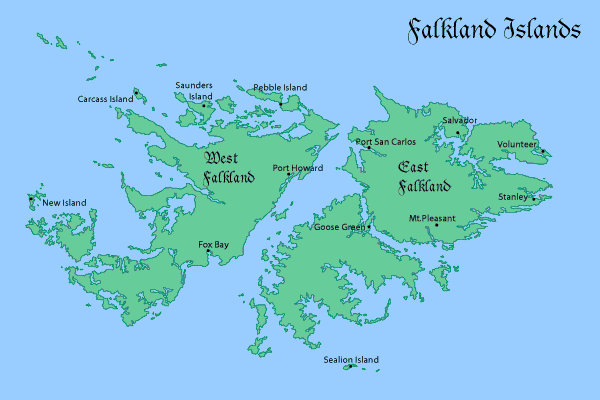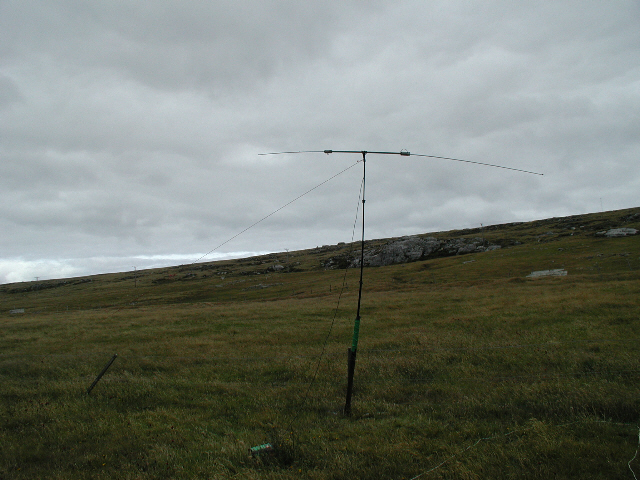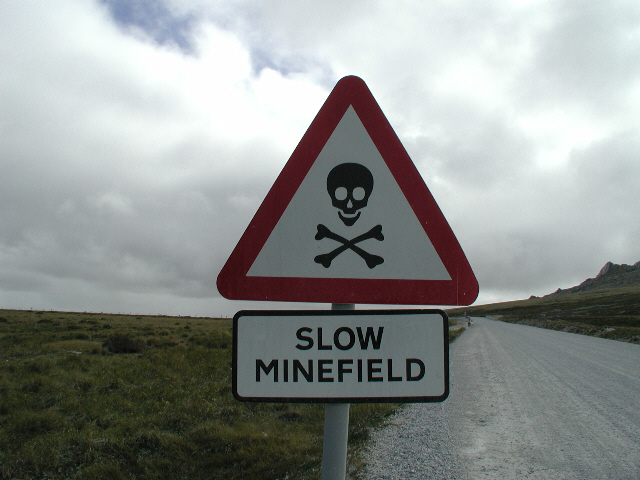

VP8 land is huge, and covers a substantial
portion of the South Atlantic Ocean land masses. I was lucky enough to be
assigned to a short task down there by my firm of the time during the 'late
summer' of 2006 - February and March !
The Falkland Islands are
located in the South Atlantic, some 51° 41' 30" South, 57° 53'
West, which equates to IARU Locator Square GD 18 bh (golf delta one
eight bravo hotel). The island itself is in CQ zone 13, ITU zone 2 and is
referred to SA-002. See maps and location pictures below.
I arrived
on East Falkland island mid-afternoon after a very long haul flight down and was
met by my station manager. After she had shown my colleague and I around, we
headed for Stanley, the capital, and were settled into the accomodation
bungalow. I knew that Amateur Radio Licences were fairly easy to come by, so we
popped into Stanley after unpacking to a) call home and say we were safe, b) get
some provisions from the local shop and c) obtain my licence. We achieved the
first two OK, but the Post Office shuts at 1600, so we had just missed it.
Never mind. The bungalow was very low down by the water (as some of the
pictures further down these pages will testify, and somewhat out of the main
part of the town, but not too far.
The next day I got to the Post
Office as it opened and asked for a licence - 10 minutes and £20 later I
was out with a lifetime licence in hand. Impressively quick and delightfully
helpful service from the ladies in the Post Office.
Falkland Islands
Location :


The VP8DJO Operator
:
I am Andy Digby, a Chartered Engineer who currently works for Cyrrus Ltd as Principal Consultant (ATC Systems). I was working for Rockwell Collins (UK) Ltd on the DHFCS programme when I was in the South Atlantic. I hold full UK Amateur Radio Licence, GWØJLX, which I have held since 1988 although since I moved to Wales in 2017 I had to add the "W" which is a Regional Secondary Locator (RSL) to indicate where the main station is now located.

The Main VP8DJO
Station :
The station equipment was very simple as I knew I was
strapped for weight on that long haul flight, so I had packed just the
trusty FT-897 and the lightweight portable Buddipole aerial. I hadn't even
bought an ATU - I was relying on the 'bar graph' readout of the rig to tell me
if I had a good aerial match or not. A good selection of clothes was more
necessary due to the uncertainties of the weather at that time of year (-2°C
to +19°C). I think my colleagues and I virtually lived in our fleeces
throughout our short tour !
The main station was located in my 'back
bedroom' of the accomodation bungalow in Stanley my two colleagues and I were
living in throughout our stay in the islands. The house was very low down near
the water line and there was a hill rising immediately behind it as well, but
the back bedroom gave me direct access to the large back garden, which became
something of an aerial farm very quickly ! The following pictures are fairly
representative of the operating situation. Note the 2m aerial magmounted up on
top of the water tank - it was the only way to get a decent ground plane going,
and provide 2m for very local contacts within and around Stanley. The all
essential washing line was also tied off to this huge tank anchor.
I
also built a 40m dipole and an 80m dipole and erected them over the bungalow
with a good length of fishing line (wonderful stuff for holding up temporary
Amateur Radio aerials) out of a couple of gash lengths of wire found lying
around. Once cut to length, they worked reasonably well into South America,
some 400-1200 miles away and were definitely NVIS antennas being so low down.
The Buddipole was erected on a rather wonky fencepost at the end of
the back garden, which was the highest point I could get it to, on top of its 12
foot extending pole (I had to be able to get at the coils and arms for band
QSY's) and fed with RG58 out of my bedroom window. This was also an NVIS dipole
to all intents and purposes and allowed me reasonable 20m, 17m and 15m contacts.
With all the necessary components in place, I was able to start
operating. I think it was at this point that I realised that I had left the
tuning chart for the Buddipole some 8500 miles away back in England. This
essential bit of paper has all the coil settings and telescopic arm settings for
each band so without it, I could not even begin to set the Buddipole up -
especially as I had no VSWR bridge, no ATU, no nothing. Hmm. . . . . so I
emailed Budd, W3FF, the designer and builder of the Buddipole for a list of
settings which duly arrived by email a few hours later. In the meantime I made
a few local contacts on 2m and had a natter. At last, I was QRV HF.





The Mobile VP8DJO
Station :
I took the station out mobile a couple of
times, the first without much success at all, I think because there was a line
of hills to my immediate North which may well have been blocking the signals
(and lets face it, there wasn't much to the South of me !).
So the next
time, I tried a different location, with the Buddipole even higher up an
adjacent hillside, but again, without a great deal of success for some reason.
On the third occasion, I was driving out towards Salvador when I found
what I thought was a really nice radio site with a long, rolling plain out to
the North which dropped away from my mobile QTH nicely, and me on a bit of
almost-flat ground adjacent to a huge flat-topped rock (useful for hopping up
onto for band QSY's if you know the Buddipole hi hi) and that was the QTH where
I managed to work a good number of contacts on the 18th March, mostly on 20m,
with a couple on 17m. My NVIS sigs were fairly weak, averaging 53-55, but
consistent, so I did manage to work several of my old friends with just 100W,
which made it all worthwhile.
The big diesel engine of the truck did a
fantastic job of keeping me warm and cosy whilst operating (and boy, was it
BITTER outside) and that day turned into a superb radio day for me.




One of the nice things about the Falklands is the amazing
amount of wildlife there - and the miles and miles of barbed wire enclosing
acres of possibly lethal mines, and some of the signs. Here are a few pictures
of just some of the things I saw on this tour. . . . . .











Unfortunately, the task my colleagues and I were sent down
to do was completed, and it was time to pack up and depart. So VP8DJO is now
QRT until the next time I get a chance to travel deep into the South Atlantic.
73 and good dx !
Please DO QSL via my home call and the buro
(GWØJLX as QSL manager) and I'll be happy to send you a card back.
Page last updated 6th January 2018